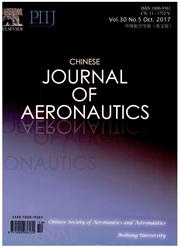

 中文摘要:
中文摘要:
The paper presents a new three-dimensional(3D) cooperative guidance approach by the receding horizon control(RHC) technique. The objective is to coordinate the impact time of a group of interceptor missiles against the stationary target. The framework of a distributed RHC scheme is developed, in which each interceptor missile is assigned its own finite-horizon optimal control problem(FHOCP) and only shares the information with its neighbors. The solution of the local FHOCP is obtained by the constrained particle swarm optimization(PSO) method that is integrated into the distributed RHC framework with enhanced equality and inequality constraints. The numerical simulations show that the proposed guidance approach is feasible to implement the cooperative engagement with satisfied accuracy of target capture. Finally, the computation efficiency of the distributed RHC scheme is discussed in consideration of the PSO parameters, control update period and prediction horizon.
 英文摘要:
英文摘要:
The paper presents a new three-dimensional (3D) cooperative guidance approach by the receding horizon control (RHC) technique. The objective is to coordinate the impact time of a group of interceptor missiles against the stationary target. The framework of a distributed RHC scheme is developed, in which each interceptor missile is assigned its own finite-horizon optimal control problem (FHOCP) and only shares the information with its neighbors. The solution of the local FHOCP is obtained by the constrained particle swarm optimization (PSO) method that is integrated into the distributed RHC framework with enhanced equality and inequality constraints. The numerical simulations show that the proposed guidance approach is feasible to implement the cooperative engagement with satisfied accuracy of target capture. Finally, the computation efficiency of the distributed RHC scheme is discussed in consideration of the PSO parameters, control update period and prediction horizon. (C) 2016 Chinese Society of Aeronautics and Astronautics. Production and hosting by Elsevier Ltd. This is an open access article under the CC BY-NC-ND license.
 同期刊论文项目
同期刊论文项目
 同项目期刊论文
同项目期刊论文
 期刊信息
期刊信息
